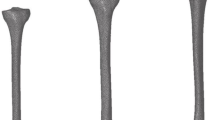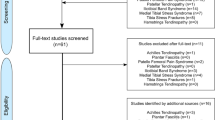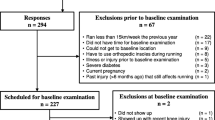Summary
Leg length inequality is a relatively common musculoskeletal malalignment related to structural, postural and environmental factors. The inequality is a plausible aetiological factor in the development of a variety of overuse injuries because it alters the magnitude and distribution of mechanical stress within the body. Leg length inequality has been linked with lower extremity stress fractures, low back pain, hip pain and vertebral disk problems of runners. The appropriateness of using inshoe lifts to reduce or eliminate the inequality has not been rigorously evaluated. Further research is needed to quantify the biomechanical effects of leg length inequality as it interacts with other factors related to running injury.
Similar content being viewed by others
References
af Geijerstam S, Meen D, Oseid S, Steinsland O. Possible causes of lower back trouble in young female gymnasts. Current Topics in Sport Medicine: 992–1001, 1984
Beal MC. The short leg problem. Journal of the American Osteopathic Association 76: 745–751, 1977
Blustein SM, D’Amico JC. Limb length discrepancy: identification, clinical significance, and management. Journal of the American Podiatry Medical Association 75: 200–206, 1985
Bottomley MB. Sacral stress fracture in a runner. British Journal of Sports Medicine 24: 243–244, 1990
Brunet ME, Cook SD, Brinker MR, Dickinson JA. A survey of running injuries in 1505 competitive and recreational runners. Journal of Sports Medicine and Physical Fitness 30: 307–315, 1990
Cavanagh PR, Andrew GC, Kram R, Rodgers MM, Sanderson DJ, et al. An approach to biomechanical profiling of elite distance runners. International Journal of Sport Biomechanics 1: 36–62, 1985
Clement DB, Taunton JE, Smart GW, McNicol KL. A survey of overuse running injuries. Physician and Sportsmedicine 9: 47–58, 1981
D’Amico JC, Dinowitz HD, Polchaninoff M. Limb length discrepancy: an electrodynographic analysis. Journal of the American Podiatry Medical Association 75: 639–643, 1985
du Plessis MP. Stress fractures and over-use syndromes. SA MedieseTydskrif 41: 670, 1980
Friberg O, Koivisto E, Wegelius C. A radiographic method for measurement of leg length inequality. Diagnostic Imaging in Clinical Medicine 54: 78–81, 1985
Friberg O, Nurminen M, Korhonen K, Soininen E, Manttari T. Accuracy and precision of clinical estimation of leg length inequality and lumbar scoliosis: comparison of clinical and radiological measurements. International Disability Studies 10: 49–53, 1988
Gibson PH, Papaioannou T, Kenwright J. The influence on the spine of leg-length discrepancy after femoral fracture. Journal of Bone and Joint Surgery 65-B: 584–587, 1983
Giles LGF, Taylor JR. Low-back pain associated with leg length inequality. Spine 6: 510–521, 1981
Giles LGF, Taylor JR. Lumbar spine structural changes associated with leg length inequality. Spine 7: 159–162, 1982
Gofton JP. Studies in osteoarthritis of the hip: Part IV. Biomechanics and clinical considerations. Canadian Medical Association Journal 104: 1007–1011, 1971
Gofton J P. Persistent low back pain and leg length disparity. Journal of Rheumatology 12: 747–750, 1985
Gofton JP, Trueman GE. Studies in osteoarthritis of the hip: Part II. Osteoarthritis of the hip and leg-length disparity. Canadian Medical Association Journal 104: 791–799, 1971
Gordon G. Podiatry sports medicine — evaluation and prevention of injuries. Podiatric Sports Medicine 1: 401–416, 1984
Gross RH. Leg length discrepancy in marathon runners. American Journal of Sports Medicine 11: 121–124, 1983
Heilig DDO. Principles of lift therapy. Journal of the American Osteopathic Association 77: 466–472, 1978
Hoyle DA, Latour M, Bohannon RW. Intraexaminer, interexaminer, and interdevice comparability of leg length measurements obtained with measuring tape and metrecom. Journal of Orthopaedic and Sports Physical Therapy 14: 263–268, 1991
James SL, Bates BT, Osternig LR. Injuries to runners. American Journal of Sports Medicine 6: 40–50, 1978
Jones CL. The damaging effects of a disaligned musculoskeletal system. Journal of the American Podiatry Association 61: 369–381, 1971
Kibler WB, Goldberg C, Chandler TJ. Functional biomechanical deficits in running athletes with plantar fascitis. American Journal of Sports Medicine 19: 66–71, 1991
Langer S. Structural leg shortage. Journal of the American Podiatry Association 66: 38–40, 1976
Lawrence D. Lateralization of weight in the presence of structural short leg: a preliminary report. Journal of Manipulative and Physiological Therapeutics 7: 105–108, 1984
Mahar RK, Kirby RD, MacLeod DA. Simulated leg-length discrepancy: its effect on mean center-of-pressure position and postural sway. Archives of Physical Medicine and Rehabilitation 66: 822–824, 1985
Maquet PGJ. Biomechanics of the knee, Springer-Verlag, New York. 1984
Matheson GO, Clement DB, McKenzie DC, Taunton JE, LLoyd-Smith DR, et al. Stress fractures in athletes: a study of 320 cases. American Journal of Sports Medicine 15: 46–58, 1987
McCaw ST, Bates BT, Singer KM. The concordance between mild leg length inequality and ground reaction force data asymmetry during running. In Gregor et al. (Eds) Proceedings of the XII International Congress of Biomechanics, 1989
Messier SP, Davis SE, Curl WW, Lowery RB, Pack RJ. Etiologic factors associated with patellofemoral pain in runners. Medicine and Science in Sports and Exercise 23: 1008–1015, 1991
Neumann DA. Biomechanical analysis of selected principles of hip joint protection. Arthritis Care and Research 2: 146–155, 1989
Pinshaw R, Atlas V, Noakes TD. Nature and response to therapy of 196 consecutive injuries seen at a runners’ clinic. SA Mediese Tydskrif 65: 291–298, 1984
Powell KE, Kohl HW, Casperson CJ, Blair SN. An epidemiological perspective on the causes of running injuries. Physician and Sportsmedicine 14: 100–114, 1986
Reid DC, Smith B. Leg length inequality: a review of etiology and management. Physiotherapy Canada 36: 177–182, 1984
Rzonca EC, Baylis WJ. Common sports injuries to the foot and leg. Clinics in Podiatric Medicine and Surgery 5: 591–612, 1988
Soukka A, Alaranta H, Tallroth K, Heliovaara M. Leg-length inequality in people of working age: the association between mild inequality and low-back pain is questionable. Spine 16: 429–431, 1991
Subotnick SI. The short-leg syndrome. Physician and Sportsmedicine 3: 61–63, 1975
Subotnick SI. The short leg syndrome. Journal of the American Podiatry Association 66: 720–723, 1976
Terjesen T, Benum P, Rossvoll I, Svenningsen S, Isern AEF, et al. Leg-length discrepancy measured by ultrasonography. Acta Orthopaedica Scandinavica 62: 121–124, 1991
Viano DC, King Al, Melvin JW, Weber K. Injury biomechanics research: an essential element in the prevention of trauma. Journal of Biomechanics 22: 403–417, 1989
Vink P, Kamphuisen HAC. Leg length inequality, pelvic tilt and lumbar back muscle activity during standing. Clinical Biomechanics 4: 115–117, 1989
Woerman AL, Binder-Macleod SA. Leg length discrepancy assessment: accuracy and precision in five clinical methods of evaluation. Journal of Orthopaedic and Sports Physical Therapy 5: 230–239, 1984
Author information
Authors and Affiliations
Rights and permissions
About this article
Cite this article
McCaw, S.T. Leg Length Inequality. Sports Medicine 14, 422–429 (1992). https://doi.org/10.2165/00007256-199214060-00008
Published:
Issue Date:
DOI: https://doi.org/10.2165/00007256-199214060-00008




